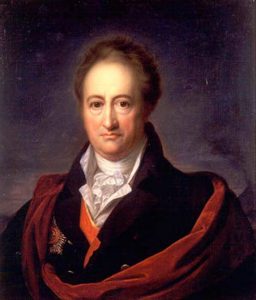Goethe “Faust”
 The great poet and thinker Goethe embodied all his life experience in the genius tragedy “Faust”. It was based on the German legend of the XVI century. about the magician and warlock, who entered into a contract with the devil. But the old story was for Goethe only a pretext to capture his thoughts on the burning issues of our time.
The great poet and thinker Goethe embodied all his life experience in the genius tragedy “Faust”. It was based on the German legend of the XVI century. about the magician and warlock, who entered into a contract with the devil. But the old story was for Goethe only a pretext to capture his thoughts on the burning issues of our time.
The plot of the tragedy combines fantastic situations and real-life scenes. This is a parable about the Man, about his duty, vocation, about his responsibility to other people.
Faust opens with two prologues. In the first of these (“The Prologue in the Theater”) Goethe expresses his views on art, the second (“The Prologue in Heaven”) directly begins the story of the hero, giving the key to understanding the ideological meaning of the tragedy. In Prologue in Heaven, Goethe uses traditional Christian imagery.
Mephistopheles, appearing before God, mocks a man, considering him miserable and insignificant. Even the pursuit of the truth of such a person as Faust seems meaningless to him. Opinion Mephistopheles Goethe contrasts the passionate faith in man, in the power and greatness of his mind. Words about this are embedded in the mouth of God:
Still wandering in the dark in the dark,
But the truth will be a ray of illumination …
Thus, in the Prologue in Heaven, Goethe gives a starting point for the struggle around Faust and predicts its optimistic resolution.
Then scene by scene reveals the story of Faust.
In the first scene of the first part before us is Faust himself. It is shown in the harsh environment of the dark office. He is surrounded by a dusty mass of books, a skull lies mysteriously in front of him. He tragically experiences his helplessness in solving the fundamental questions of life, for science is not able to answer them.
Faust is contrasted with the image of Wagner, a self-satisfied man in science who sees the whole point of his scholarship only in
…absorb
Behind the volume, page by page!
“The insignificant worm of dry science,” as Faust scornfully characterizes him, Wagner embodies a dead theory, divorced from practice, far from life.
The deep meaning of contrasting these two images with great artistic skill is revealed in the scene “Behind the city gates”. Before us are peasants, artisans, burghers, students, maids. On a joyful spring holiday, they gathered under the jubilant sun on a green lawn near the walls of the ancient medieval city. The whole scene is fanned by a bright sense of the awakening of nature. But not only nature woke up after a winter sleep. It seems to Faust that the whole world is celebrating its resurrection.
From a stuffy room, from hard work,
From the shops, from its close workshop,
From the darkness of attics, from under the carved roof
People rushed to the crowd of fun …
Faust happily mingles with a crowd of peasants. The people respectfully meet the doctor and thanks him for his help during the epidemic.
Faust seeks to find the truth and understands that it must be sought not in the dead rubbish of old books, as Wagner does. With disdain, he also rejects the pitiful temptations of Mephistopheles, who would like to stun him with merry revelry and thus divert him from noble goals.
In the scene of the translation of the Gospel, Faust painfully searches for the meaning of life. He is not satisfied with the formula: “In the beginning was the Word.” “I can not appreciate the Word so highly!” Conclusion, to which Faust comes: “At the beginning was the Case.”
The scenes depicting the tragedy of Margarita are attracted by the masterful depiction of the life of the German province of that time. Margarita is a simple, modest girl. But it is this simplicity and naivety, the quiet family life of her house that fascinates Faust.
Mephistopheles hopes that, fascinated by Margarita, Faust will forget about his quest. He does not understand that the sincere, deep feeling of Faust is a manifestation of the same quest; Margarita for him personifies the beauty and fullness of life. Her immediacy and simplicity seem to him the embodiment of nature.
“Ah, two souls live in my chest!” – Faust exclaims (in the scene “Behind the city gates”). Faust seeks to know the ideal, but on the other hand, he does not want to lose touch with reality. How to reconcile these “two souls” – the desire for the ideal and the desire to stay on the basis of reality? This question painfully worries Faust and Goethe himself.
It seemed to Faust that a meeting with Margarita would bring happiness, for this girl seemed to combine ideals and life. But it was a tragic delusion. Margarita’s world turned out to be a little world girl from a provincial backwater. And Faust tends to active life.
In the final of the first part, left by Faust, who killed her child, distraught by grief, Margaret is waiting for execution. This is one of the exciting scenes of the tragedy.
The change of poetic rhythms expressively conveys an irresistible stream of conflicting feelings of the heroine.



